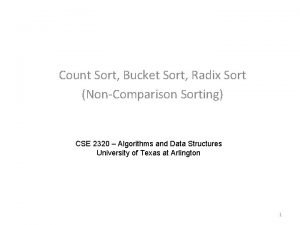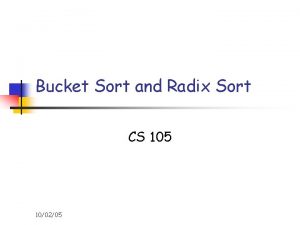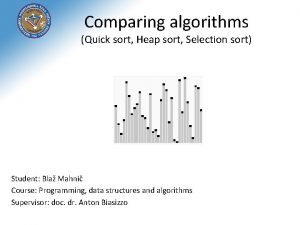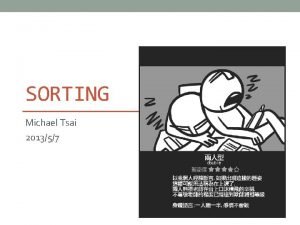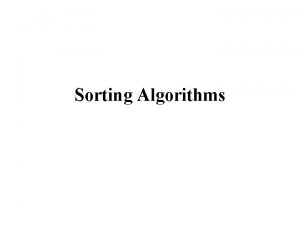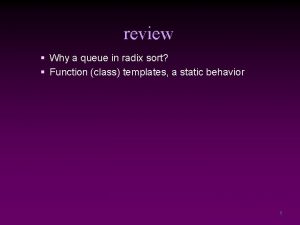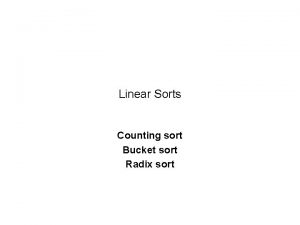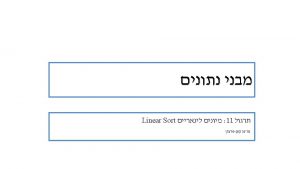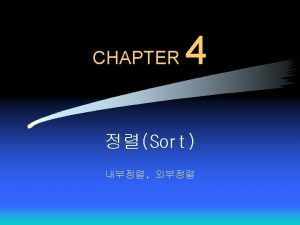Quick sort and Radix sort Rahul Sehgal rsehgalcs










- Slides: 10

Quick sort and Radix sort Rahul Sehgal rsehgal@cs. kent. edu

Outline • Comparison sort (quick sort) and execution example • Linear sort (radix sort) and execution example • Worst case situation for linear sort and quick sort. 12/6/2020 Rahul Sehgal, Kent State University 2

Comparison Sort (Quick Sort) • Comparison sort: sorted order is determined based only on comparisons between the input elements. • Quick sort: based on the divide-and-conquer paradigm. Process for sorting a typical sub-array A[p. . r]. – Divide: Partition (rearrange) the array A[p. . r] into two (possibly empty) subarrays A[p. . q − 1] and A[q +1. . r] such that each element of A[p. . q − 1] is less than or equal to A[q], which is, in turn, less than or equal to each element of A[q + 1. . r]. 12/6/2020 Rahul Sehgal, Kent State University 3

Quick Sort: conquer and combine – Conquer: Sort the two subarrays A[p. . q− 1] and A[q +1. . r] by recursive calls to quicksort. – Combine: Since the subarrays are sorted in place, no work is needed to combine them: the entire array A[p. . r] is now sorted. 12/6/2020 Rahul Sehgal, Kent State University 4

Quick sort- partition i j r p 2 8 7 1 3 5 6 4 j i r p 2 1 7 8 3 5 6 4 i j r p 2 1 3 8 7 5 6 4 p 2 1 3 4 7 5 6 8 12/6/2020 Rahul Sehgal, Kent State University r 5

Quick sort- execution q p 2 1 3 4 7 5 6 8 r q 2 1 3 2 1 1 2 3 1 2 2 To sort an entire array A the initial call is QUICKSORT(A, 1, length[A]). 12/6/2020 Rahul Sehgal, Kent State University 6

Quick sort- analysis • The worst case for quick-sort occurs when the pivot is the unique minimum or maximum element, also known as one sided partition. • Input elements sorted or reverse sorted. • Worst case time: O(nᶺ 2) • Average case: O(nlogn) 12/6/2020 Rahul Sehgal, Kent State University 7

Linear sort (Radix sort) • Linear sort: Any comparison sort algorithm takes Ω(nlogn) in the worst case to sort n elements. Can we do better? • Yes, but we have to make assumptions that we have integers as input sequence which are in a small range (0 to k) or input is generated by a random process that distributes elements uniformly over the interval. • We get deterministic about input. If k is large our runtime will increase. • Radix sort: we do digit by digit sort. Starting from least significant digit. 12/6/2020 Rahul Sehgal, Kent State University 8

Radix sort- execution example • Input sequence: 329, 457, 657, 839, 436, 720, 355 • If digits are same we preserve order. 12/6/2020 Rahul Sehgal, Kent State University 9

Radix sort - analysis • We represent each element as a b-tuple of integers in the range [0, 1] and apply radixsort with N = 2. • Worst case O(bn) – n # of elements (integers), each integer is b-bits long. • Not good if range increases. 12/6/2020 Rahul Sehgal, Kent State University 10

